Global digital lending market is estimated to be valued at US$ 17.75 Bn in 2025 and is expected to reach US$ 38.54 Bn by 2032, exhibiting a compound annual growth rate (CAGR) of 11.7% from 2025 to 2032.
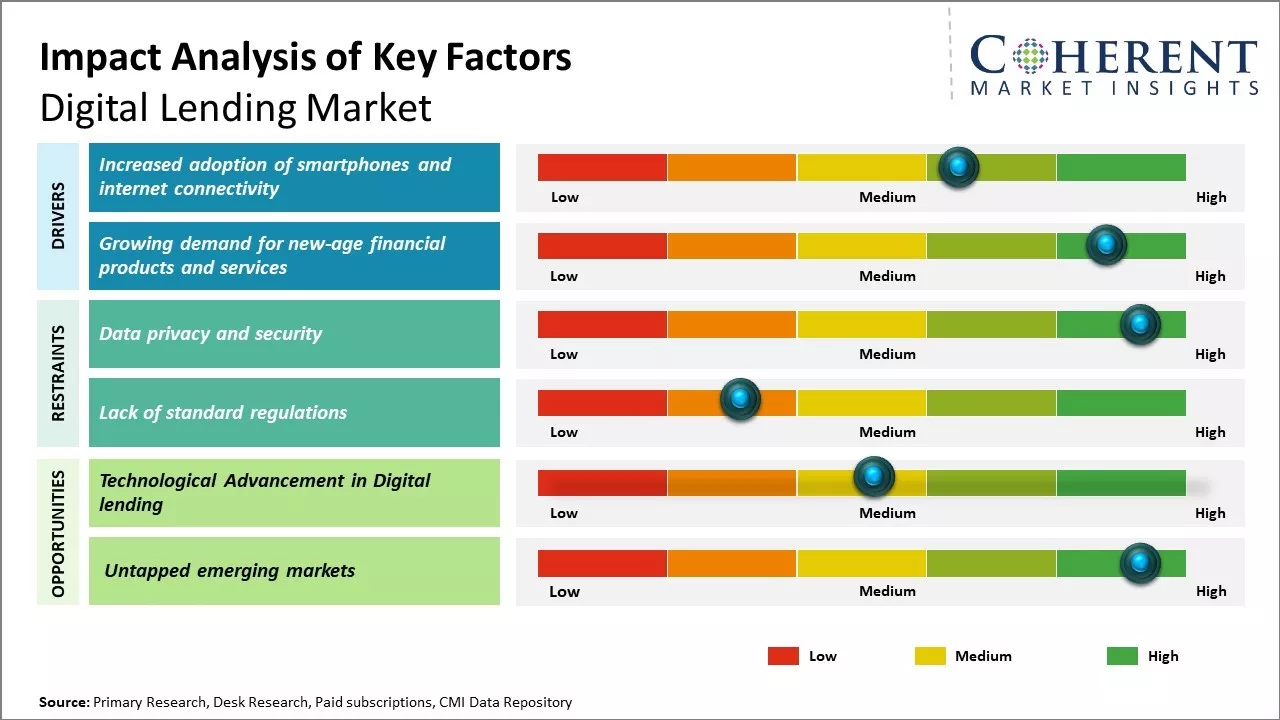
Discover market dynamics shaping the industry: Request sample copy
Rising adoption of digital lending platforms for personal loans, business loans, and other financial services can drive the market growth. Consumers find digital lending platforms more convenient and easy to use as compared to traditional options as these provide faster loan approval and disbursals. These platforms help financial institutions to improve their credit underwriting and risk management.
Using advanced analytics helps understand customer risk better. By investing more in artificial intelligence and machine learning, online lending platforms are likely to become even more popular. Innovative businesses are leveraging these platforms to access credit and fulfill their financial needs easily.
Increased adoption of smartphones and internet connectivity
Due to rapid growth of smartphone users and internet connectivity across both developed and developing economies, there has been huge demand for digital lending services. The number of people accessing the internet through their smartphones has increased exponentially in the last 5 years alone. Smartphones have become more affordable and even basic models are capable of running various lending applications. This has allowed millions of individuals who previously did not have access to formal banking to now avail quick and easy loans on their phones.
The widespread availability of high-speed 4G networks boosts adoption of digital lending. People can now apply for loans from the convenience of their homes or workplaces without having to physically visit a bank branch. This is a huge advantage for customers who need emergency funds for unexpected expenses. Lenders too have benefited from this digital transformation as it allows them to reach out to a much larger customer base at lower acquisition costs compared to traditional channels.
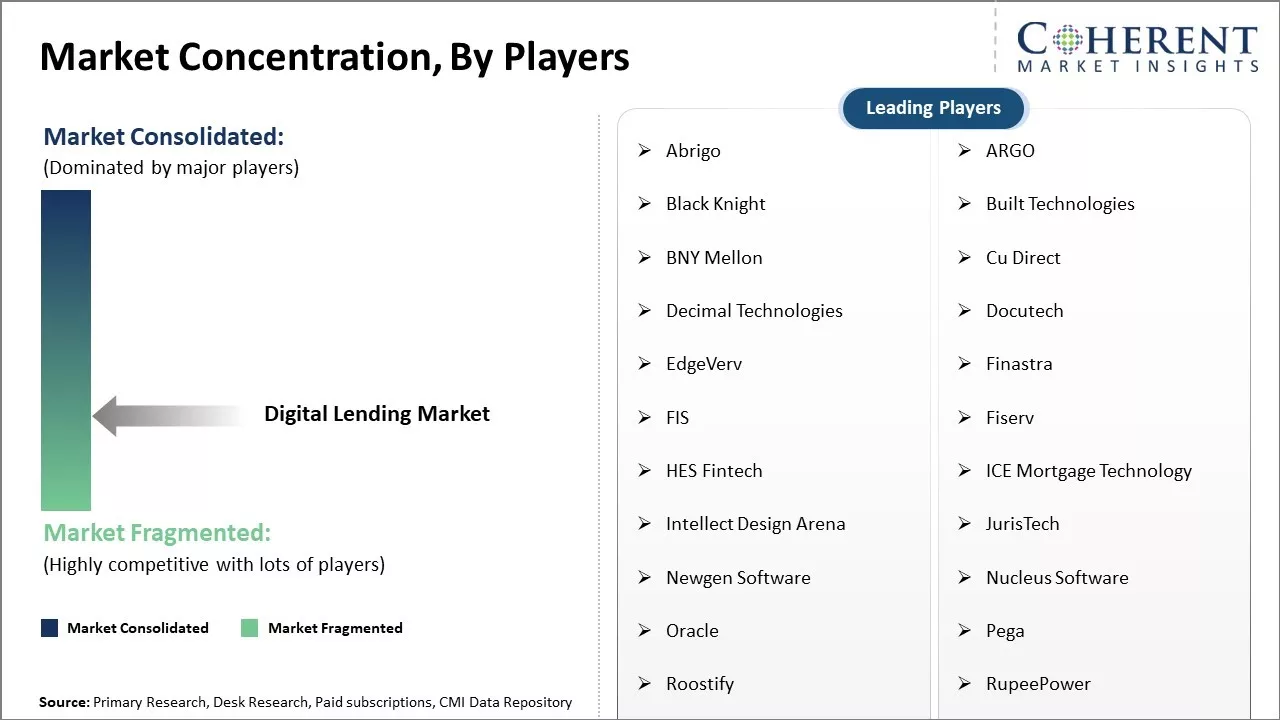
Get actionable strategies to beat competition: Request sample copy
Growing demand for new-age financial products and servicesWith rising aspirations and changing lifestyles, there is a rising requirement for more customized and specialized financial solutions catering to diverse needs. Needs which were previously fulfilled through informal avenues or not addressed at all. Therigidity of traditional banks in terms of eligibility, documentation and turnaround times does not permit them to offer differentiated products at large scale. However, digital lending platforms have stepped in to fill this void with new-age solutions.
There has been huge demand for small-ticket personal loans for purposes like funding hobbies, one-time expenses, vacations and others. Millennials want instant credit solutions to shop online without having to use savings. New businesses need working capital or inventory funding at short notice to cater to spikes in demand. Digital lenders have designed loan programs tailored for each segment after thoroughly understanding their profile and risk appetite. Furthermore, their use of alternate data sets and new-age analytical models have enabled approval of loans to customers who would otherwise be rejected by banks. This shift towards a more inclusive and customized model of lending is driving the market growth.
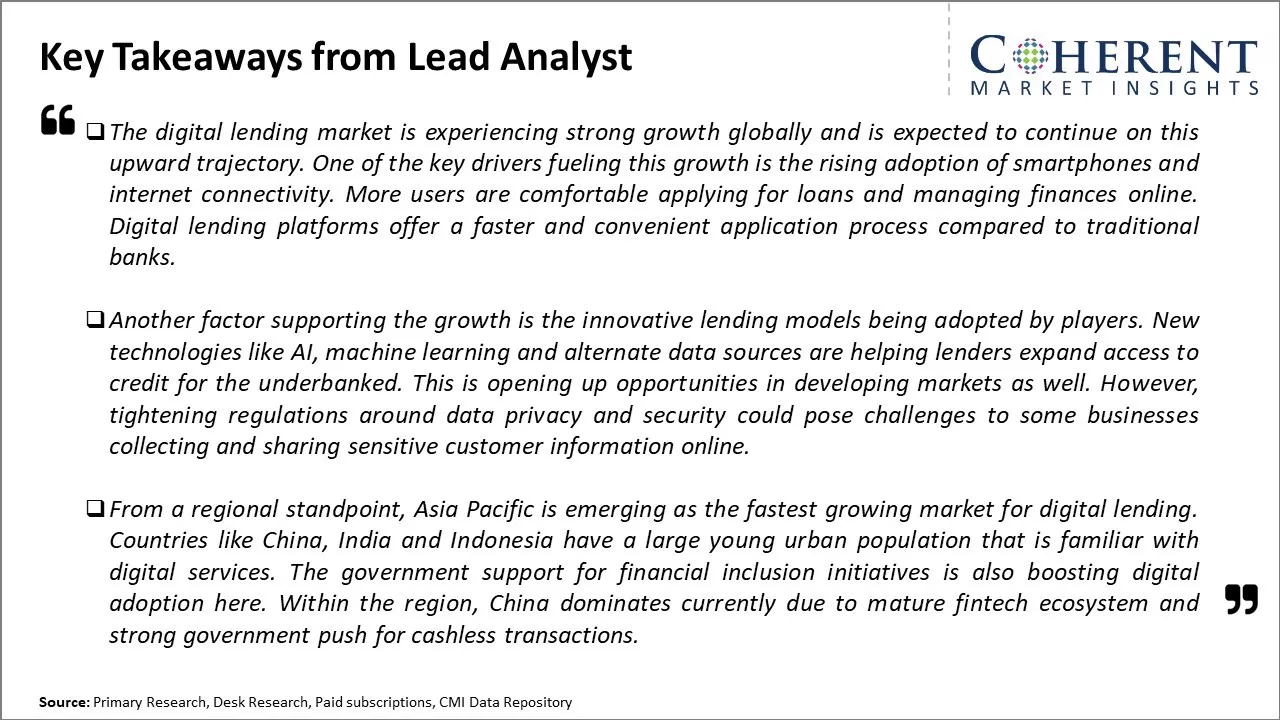
To learn more about this report, Request sample copy
Market Challenge: Data privacy and securityFraud is a major issue as lenders work to verify identities and incomes online without in-person interactions. Data privacy and security are also of high concern, as personal consumer financial information must be protected from theft or misuse. Regulations can struggle to keep up with rapidly evolving lending technologies, creating ambiguity that hampers innovation. Additionally, gaining consumer trust in automated and algorithm-driven lending processes takes time as many customers still prefer human interactions when it comes to obtaining loans.
Market Opportunity: Technological Advancement in Digital lending
As technology makes the lending process simpler, quicker and more convenient for borrowers, there has been rising demand for digital lending. Removal of physical branches allows for streamlined operations and lower overhead costs. Data analytics further expand access to credit by helping lenders better evaluate risk for more customer groups.
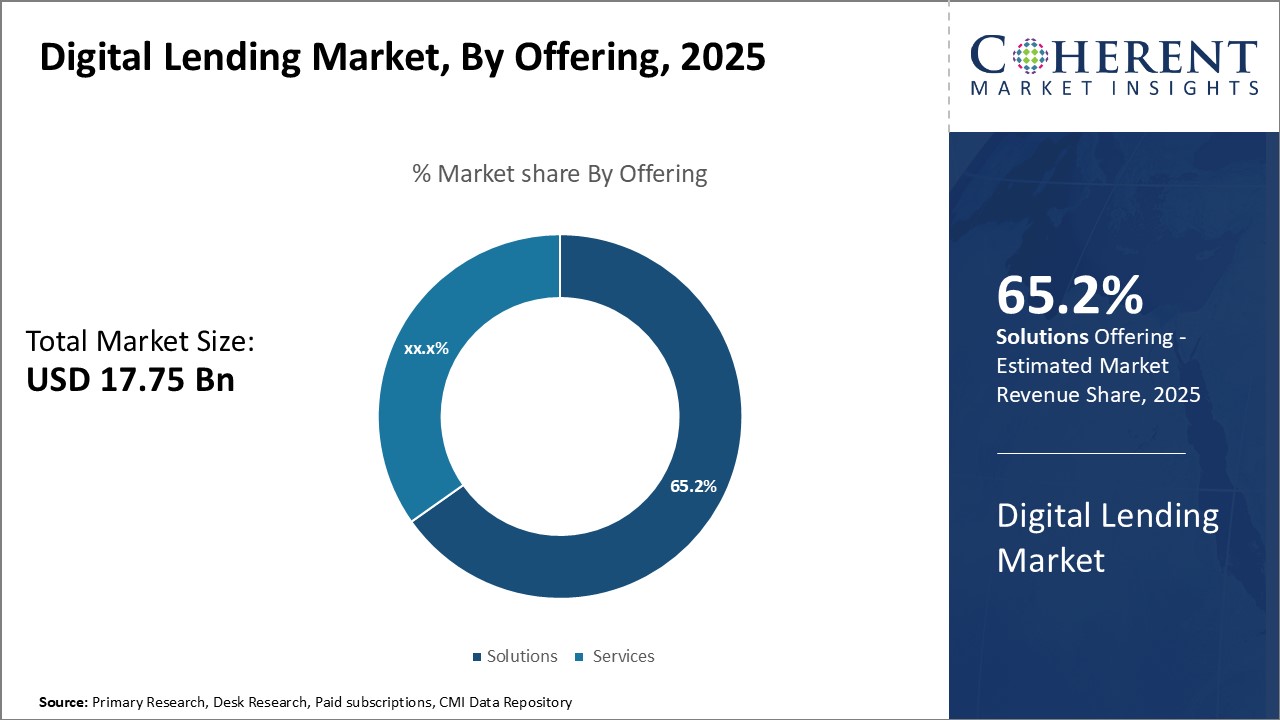
Discover high revenue pocket segments and roadmap to it: Request sample copy
Insights, By Offering- Rise of digitization boosts demand for digital lending solutionsIn terms of offering, solutions segment is estimated to contribute the highest share of the market owing 65.2% in 2025 due to growing demand for digital and automated lending platforms. As financial institutions aim to offer seamless digital experiences to their customers, there is increased focus on implementing innovative lending solutions. Various factors such as the proliferation of smartphones and growing Internet penetration have accelerated the shift towards digitization of financial services. Customers now expect banking services to be online and on-the-go. Moreover, with rising security and privacy concerns regarding data stored online, lending solutions equipped with advanced technologies like blockchain and biometrics are gaining traction. The COVID-19 pandemic has further accelerated this digital transformation, compelling banks and other lenders to strengthen their online capabilities. This has boosted the implementation of digital lending solutions that enable automated underwriting, real-time decisions, electronic documentation, and digital signatures. Their ability to streamline and simplify processes while enhancing the customer experience is a key driver of growth of segment.
Insights, By Deployment Mode- On-Premises deployments remain crucial for security sensitive operations
In terms of deployment mode, on-premises segment is estimated to contribute the highest share of the market owing 75.2% in 2025 as many financial institutions prefer retaining control over critical systems and data. While cloud-based digital lending platforms offer scalability and other operational benefits, on-premises deployments allow sensitive consumer and financial information to be stored within the organization's customized private IT infrastructure. This addresses major security concerns for financial operations that involve consumer credit profiles and underwriting decisions. Regulatory obligations regarding data sovereignty and restrictions on cross-border data transfers have also boosted on-premises implementations. Moreover, customized on-premises deployments provide flexibility to integrate legacy systems and ensure seamless experience across channels. Their capability to isolate critical systems enhances reliability. However, increasing recognition of hybrid cloud and multi-cloud architectures is expected to drive future growth of cloud-based lending solutions as well.
Insights, By End User- Banks lead digital lending adoption owing to size and resources
In terms of end user, banks segment is estimated to contribute the highest share of 69.6% in 2025 of the market due to their size, footprint, and resources. Large banks have been quick to adopt digital lending capabilities to offer customized and competitive products. Their scale enables investments into developing advanced platforms and integrating innovative technologies. Additionally, banks work in different areas of business, giving them a complete picture of customers. This helps them create personalized online lending options and use data to predict outcomes. However, to remain relevant these are partnering with FinTechs and adopting open banking/API strategies. The consolidated growth across all end user segments is expected as digital transformation becomes imperative for competitive survival in the lending landscape.
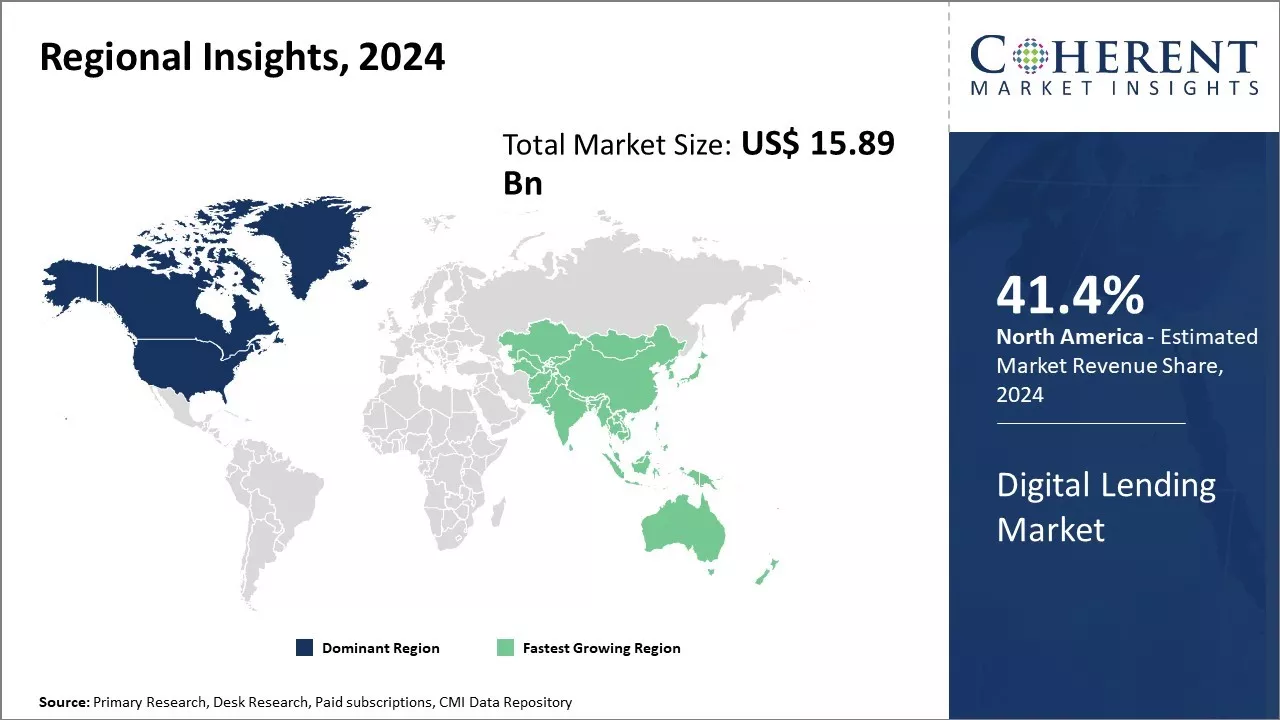
Need a Different Region or Segment? Customize now
North America has established itself as the dominant region in the digital lending market. With the strong presence of major financial institutions and fintech companies, countries like the U.S. and Canada have widely adopted various digital lending solutions across both consumer and enterprise segments. The advanced technological infrastructure and high internet penetration in the region allows for seamless digital lending experiences.
North America witnesses increasing demand for fast and customizable lending options from small businesses. Traditional lending processes are unable to meet the dynamic needs of SMEs, and thus, digital lending platforms provide an automated and flexible way for SMEs to access capital quickly. This factor drives several businesses in North America to turn to digital channels to fulfill their financing requirements. The area also has a lively startup scene that depends on online lending to grow and expand.
Asia Pacific region has emerged as the fastest growing digital lending market globally. Several developing countries in South and Southeast Asia are experiencing exponential economic growth and witnessing a massive rise in internet and smartphone users each year. Countries such as India, Indonesia, and the Philippines are attracting huge investments from global fintech players looking to tap into the region's demographic dividends.
India, in particular, stands out due to its huge underbanked population that relies heavily on digital lending platforms for credit. Major Indian players like Paytm, Capital Float and LoanTap are making financial services easily accessible even in remote areas through their mobile-based lending solutions. These are meeting the latent demand by offering small-ticket personal loans, along with innovative business credit products tailored for India's large retail merchant base. The success of such digital lending businesses in India is encouraging global investments and boosting adoption across other South Asian countries as well. With ongoing efforts to include more people in finance and better internet access, the Asia Pacific area still has lots of chances for the digital lending sector to grow in the future.
Digital Lending Market Report Coverage
| Report Coverage | Details | ||
|---|---|---|---|
| Base Year: | 2024 | Market Size in 2025: | USD 17.75 Bn |
| Historical Data for: | 2020 To 2024 | Forecast Period: | 2025 To 2032 |
| Forecast Period 2025 to 2032 CAGR: | 11.7% | 2032 Value Projection: | USD 38.54 Bn |
| Geographies covered: |
|
||
| Segments covered: |
|
||
| Companies covered: |
Abrigo, ARGO, Black Knight, Built Technologies, BNY Mellon, Cu Direct, Decimal Technologies, Docutech, EdgeVerv, Finastra, FIS, Fiserv, HES Fintech, ICE Mortgage Technology, Intellect Design Arena, JurisTech, Newgen Software, Nucleus Software, Oracle, Pega, Roostify, RupeePower, SAP, Sigma Infosolutions, Symitar, Tavant, TCS, Temenos, Turnkey Lenders, Wipro, Wizni |
||
| Growth Drivers: |
|
||
| Restraints & Challenges: |
|
||
Uncover macros and micros vetted on 75+ parameters: Get instant access to report
*Definition: Digital lending market enables lending organizations to simplify, automate and digitize their lending processes using technologies like artificial intelligence, machine learning, cloud computing, blockchain and big data analytics. This allows lenders to quickly assess loan applications, verify identities, assess credit risks, customize loan offers and enable seamless disbursements and collections through digital platforms. The digital lending solution helps lenders improve lending operations, reduce costs and risks while enhancing customer experience through a fully digitized lending lifecycle.
Share
Share
About Author
Monica Shevgan has 9+ years of experience in market research and business consulting driving client-centric product delivery of the Information and Communication Technology (ICT) team, enhancing client experiences, and shaping business strategy for optimal outcomes. Passionate about client success.
Missing comfort of reading report in your local language? Find your preferred language :
Transform your Strategy with Exclusive Trending Reports :
Frequently Asked Questions
Joining thousands of companies around the world committed to making the Excellent Business Solutions.
View All Our Clients
US Reciprocal Tax Impact Analysis On Digital Lending Market
Stay updated on tariff changes with expert insights and timely information